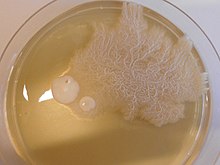Dimorphic fungus

Dimorphic fungi are
The term dimorphic is commonly used for fungi that can grow both as yeast and filamentous cells, however many of these dimorphic fungi actually can grow in more than these two forms. Dimorphic is thus often used as a general reference for fungi being able to switch between yeast and filamentous cells, but not necessary limiting more shapes.[4][a]
Ecology of dimorphic fungi
Several species of dimorphic fungi are important pathogens of humans and other animals, including
- sporotrichosis
- blastomycosis
- histoplasmosis
- coccidioidomycosis
- paracoccidioidomycosis
- talaromycosis
- candidiasis[a]
Many other fungi, including the plant pathogen
Mnemonics
In medical mycology, these memory aids help students remember that among human pathogens, dimorphism largely reflects temperature:
- Mold in the Cold, Yeast in the Heat (Beast)
- Body Heat Probably (Changes) Shape
- spherule of endospores, not yeast, in the heat), Sporothrix schenckii.
- This phrase says "Probably" because there is always an exception (in this case fungi like Candida albicans) which change in the opposite direction: to mold in the heat!
Notes
- ^ a b c d e f g h e.g. Candida albicans, Paracoccidioides brasiliensis, Sporothrix schenckii, Histoplasma capsulatum and Coccidioides immitis are commonly referred to as being dimorphic, however they can be seen as pleomorphic or polyphenic as they can adopt more morphologies than just yeast or filamentous cells.[8][4]
References
- ^ "Fungi". Archived from the original on June 6, 2009. Retrieved 2009-06-06.
- PMID 28626346.
- PMID 18533041.
- ^ ISBN 978-1-4615-2834-0.
- ^ a b "Dimorphic Fungi". Retrieved 2007-08-19.
- ^ PMID 11282479.
- S2CID 15865.
- PMID 27867199.
